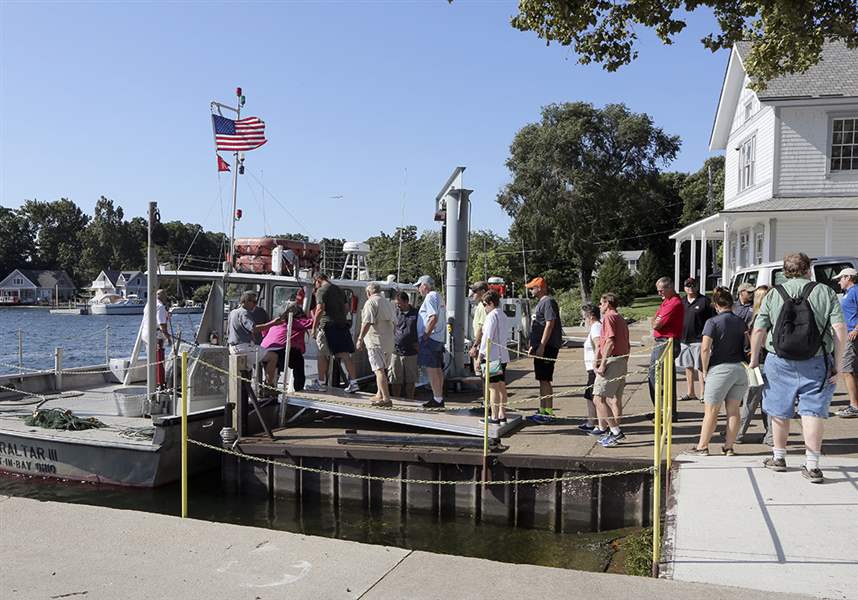
Budget riles area tourism businesses
Trump plan to end Lake Erie initiative could threaten coastal communities’ economies
3/26/2017
Ohio State University’s F.T.Stone Laboratory on Gibraltar Island is in Put-in-Bay. For many towns on the lakeshore, it’s nearly impossible to separate their economies from the lake. According to a 2015 study, visitors to these communities spend $14.1 billion a year.
THE BLADE
Buy This Image
A federally funded effort to clean up Lake Erie has been targeted for elimination by President Trump, a move that has riled local business leaders who fear the proposed cuts would have severe economic consequences across northern Ohio.
“Our entire lifeline is connected to the lake, whether it’s the Jet Express and people coming into town, our fishing industry, everything is tied to the lake,” said Nikki Adams, president of Port Clinton Area Chamber of Commerce.

Passengers on the Jet Express Ferry travel to Put-in-Bay, Ohio, for fun on the island. But algal blooms put a damper on charters when the boats can’t get out of the green water.
Lake Erie is unquestionably one of Ohio’s tourism jewels, drawing boaters, birders, and sunbathers from all over the region. Those visitors spend big bucks — $14.1 billion a year according to a 2015 study by Tourism Economics. The same study found tourism supports nearly 124,000 jobs in Ohio’s eight coastal counties.
For many of the towns that dot the lakeshore, it’s nearly impossible to separate their economy from the lake.
“To Port Clinton it’s everything. It’s our livelihood,” said Jan Czerwinski, who runs Sassy Sal Charters in Port Clinton. “There’s a lot of small-business owners in this area that employ a lot of people. Without the lake we might just as well move somewhere else.”
The company operates two charter boats, one a 63-footer that can accommodate up to 42 people. The healthier the lake, the better the fishing. Killing the funding, Ms. Czerwinski worries, could mean killing the fishing.
“It’s very important that we keep research going for clean water and invasive species. It’s got to keep going in that direction, period,” she said.
That sentiment is shared by many in Ottawa County, where development officials said nearly 17 percent of the work force is in the tourism sector. Based on data from Ohio Job and Family Services, that works out to more than 3,300 people.
A look at Ottawa County’s fluctuating unemployment rate demonstrates how important tourism is.
From May through September of last year — prime tourism season — Ottawa County’s unemployment rate hovered around 4.9 percent. It spiked to 10.1 percent in January. The situation is similar in other tourism-dependent lake counties. In Erie County, the jobless rate averaged 4.8 percent from May through September, spiking in January to 7.5 percent. Similar swings occur in Sandusky County, with a rate of about 4.2 percent May through September and spiking to 6.1 percent in January.
Local officials say those are longstanding trends that reflect just how prevalent the summer tourism industry is there.
“I know people are just scared to death right now that budget might be cut as deep as they’re talking about,” Ms. Adams said.
Established under President Barack Obama in 2010, the Great Lakes Restoration Initiative has funded work to restore natural habitats, combat invasive species, and clean up pollution. It’s also done work to reduce the nutrient load that leads to harmful algal blooms like the one that fouled Toledo’s drinking water in 2014. The program funds work across the Great Lakes region, which has included dozens of projects in northwest Ohio.
But as part of Mr. Trump’s austere budget request for the U.S. Environmental Protection Agency, the $300 million a year initiative has been dumped. In the summary of the EPA budget proposal, the White House suggested the cut “returns the responsibility for funding local environmental efforts and programs to State and local entities, allowing EPA to focus on its highest national priorities.”
Tourism boards, business officials, and researchers alike view the decision as a tremendous mistake.
“The Great Lakes are the heart of the middle of the country, and we should feel betrayed by this budget,” said Christine Mayer, professor in the department of environmental sciences at the University of Toledo’s Lake Erie Center. “The Great Lakes are an economic, cultural, environmental, social driver for the Midwest. To zero them out of a budget is irresponsible.”

Ohio State University’s F.T.Stone Laboratory on Gibraltar Island is in Put-in-Bay. For many towns on the lakeshore, it’s nearly impossible to separate their economies from the lake. According to a 2015 study, visitors to these communities spend $14.1 billion a year.
Experts at the Lake Erie Center say the two biggest threats Lake Erie faces are invasive species and the algal blooms fed by agricultural runoff. Left unchecked, both have the potential to wreck the lake’s ecosystem, and local economies with it.
“You can lose a generation of visitors to Lake Erie if they come to a beach and it’s covered with green slime, not to mention the tens of thousands of dollars per day just the city of Toledo spends in treatment costs during one of the algal blooms,” said Thomas Bridgeman, a professor in the department of environmental sciences at the Lake Erie Center.
Both professors said the Great Lakes Restoration Initiative has made real progress and that they fear cutting the program would have very real implications. They also say the three-day crisis in August, 2014, in which half a million people in metro Toledo were warned their tap water was not safe was a big wakeup call for many people.
“I do think the awareness changed when we were told not to drink our water. Think about businesses that were impacted by that. If we do not have clean drinking water, restaurants can’t be open,” Ms. Mayer said. “The economic activity that’s supported by us having clean water straight out of the tap, it touches every business in every city surrounding the lake.”
Bipartisan opposition
It’s not clear how much congressional support there would be to cut — let alone eliminate — the funding. In the week since the White House released its budget outline, there has been bipartisan opposition from local congressmen.
Ohio Sen. Rob Portman, a Republican, and Sen. Sherrod Brown, a Democrat, both expressed a strong defense for Great Lakes Restoration Initiative. Mr. Portman wrote an op-ed column that was published in The Blade; Mr. Brown gave an impassioned speech in the Senate in which he said cutting the initiative would threaten jobs and public health.
Even U.S. Rep. Jim Jordan, a Republican from Urbana, Ohio, who is regularly recognized as one of Congress’ most conservative members and whose district includes coastline in Sandusky County, has come out in support of the restoration initiative.
“Lake Erie impacts our area in so many ways, and I believe protecting the Great Lakes requires a coordinated effort between local, state and federal governments, and the public,” Mr. Jordan said in a statement to The Blade.
“While I am as fiscally conservative as they come, and I believe we must set strict spending priorities in order to balance the federal budget, I support federal involvement in the Great Lakes Restoration Initiative,” his statement said.
That support is encouraging for local business groups, though they intend to keep the pressure on legislators and others in Washington. But the mere idea that funding could be cut has galvanized local business groups and tourism officials in their defense of the funding and its economic importance.
“From an economic standpoint the future of the lake is very import to our organization,” said Jamie Beier Grant, the director of Ottawa County Improvement Corp., a local development group. “It’s vital to Ottawa County and it’s one of the last large freshwater resources we have in the country. Keeping the health of Lake Erie, bottom line, it’s just very important to our region and to the state.”
Reliance on the lake
Several groups, including the Ottawa County Improvement Corp., are working to quantify the restoration initiative’s impact and the return on Washington’s investment with real hard data. These groups believe the numbers are there.
Larry Fletcher, executive director of the tourism group Lake Erie Shores & Islands, noted almost 700 charter boat captains are licensed in Ohio. Those operations, Mr. Fletcher said, support hundreds of bait shops, restaurants, and other businesses.
All of those were hurt by the 2015 algal bloom — the biggest on record.
“A lot of charter captains were not able to operate. They simply could not take their customers out. They couldn’t get out of the green water,” Mr. Fletcher said.
He also points to the impact of birding, which brought an estimated 90,000 people to the Magee Marsh boardwalk in Ottawa County last year, generating $30 million in economic activity.
Ottawa County has other major employment sectors besides tourism — manufacturing still accounts for about 14 percent of total county employment — but even some of the county’s largest employers rely on the lake. With about 700 employees, the Davis-Besse nuclear power plant tops the list as Ottawa County’s largest employer. The plant draws cooling water from Lake Erie.
One of the development strategies the Ottawa County Improvement Corp. has embraced is reaching out to companies whose business models require plentiful clean water.
While there has been some talk that severe droughts like the one California experienced starting in 2011 could push some firms to look to other regions where the water supply was more secure, most experts say that hasn’t yet happened to any large extent.
Selling point
Even so, Dennis McAndrew, a principal with Silverlode Consulting in Cleveland, said companies that are looking to expand or relocate do consider every potential risk, including water.
“That perception that the lake might in the future be less of a resource than it is today or less of a benefit than it is today, it’s a big and serious knock,” he said.
Site consultants have noticed economic development groups across the country push availability to water as a big selling point, Mr. McAndrew said, though he’s not aware of companies considering northern Ohio solely because of the lake. But the area is getting more attention overall, and it’s important that environmental concerns don’t crop up that could imperil that.
“Northern Ohio is kind of getting on that map again, and the last thing the area needs is any negative publicity that the direction the lake is headed in,” he said. “It doesn’t take too many Toledo water events for people to start wondering about where things are headed for Lake Erie.”
Contact Mike Sigov at: sigov@theblade.com, 419-724-6089, or on Twitter @mikesigovblade.